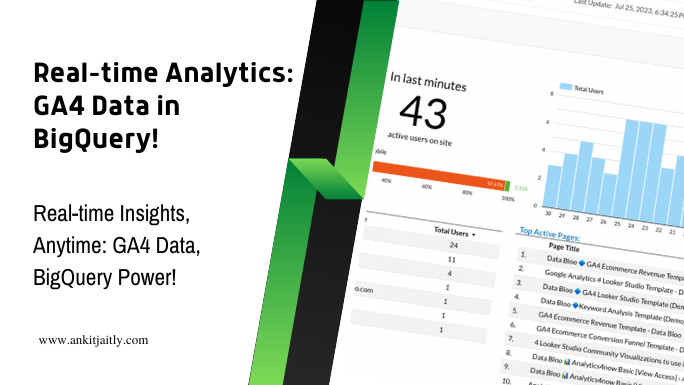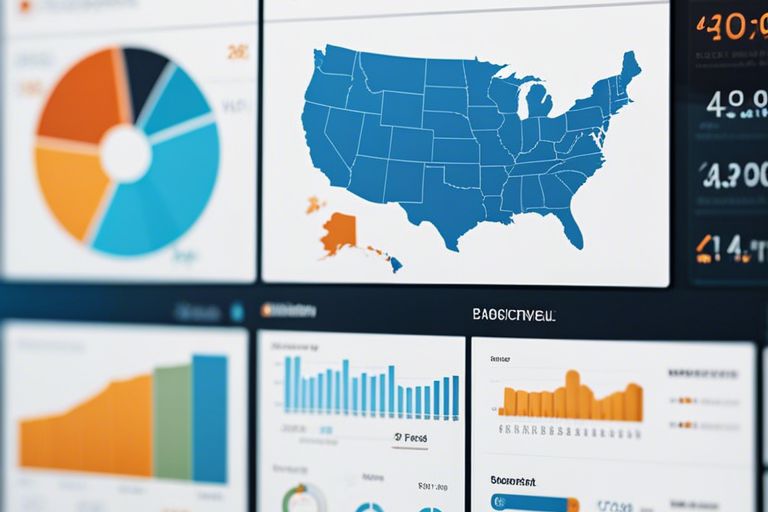Obtaining real-time analytics on your website or app’s performance has become increasingly important in today’s fast-paced digital world. With the recent release of Google Analytics 4 (GA4), many businesses and organizations are eager to leverage the power of BigQuery to analyze their data in real-time. In this guide, we will explore the capabilities and limitations of running real-time analytics on GA4 data with BigQuery, as well as provide insights into the best practices and potential challenges that come with this process.
In this guide, we will delve into the complexities of BigQuery and its ability to process and analyze GA4 data in real time. From highlighting the advantages of running real-time analytics to addressing potential obstacles and limitations, this comprehensive overview will equip you with the knowledge and understanding needed to make informed decisions when it comes to leveraging Google Analytics 4 data with BigQuery. Whether you are a business owner, data analyst, or digital marketer, this guide is designed to provide valuable insights and guidance on this pertinent topic.Understanding Real-Time Analytics
Before diving into how to run real-time analytics on Google Analytics 4 (GA4) data with BigQuery, it’s important to have a clear understanding of what real-time analytics actually entails. Real-time analytics involves analyzing data as it is generated, providing immediate insights and actionable information. This allows businesses to make quick decisions, respond to events as they occur, and optimize user experiences in the moment.
// Sample real-time analytics code
const realtimeData = getRealtimeData();
analyze(realtimeData);
Types of Real-Time Data in GA4
Real-time data in GA4 includes real-time active users, real-time events, real-time conversions, and real-time user properties. This data provides immediate insights into user behavior, engagement, and conversion events as they occur on your website or app. Understanding these different types of real-time data is crucial for making informed decisions in real-time.
// Sample code to retrieve real-time active users in GA4
const activeUsers = getRealtimeActiveUsers();
- Real-time active users
- Real-time events
- Real-time conversions
- Real-time user properties
- Thorough understanding of real-time data is essential for effective decision-making.
Factors Affecting Real-Time Analytics
Real-time analytics can be affected by data latency, system performance, network speed and stability, and data volume. Any issues with these factors can impact the accuracy and timeliness of real-time analytics, leading to potential data discrepancies or delays in insights. It’s important to monitor and address these factors to ensure reliable real-time analytics.
// Sample code to monitor system performance for real-time analytics
const systemPerformance = checkSystemPerformance();
- Data latency
- System performance
- Network speed and stability
- Data volume
- Any issues with these factors can impact the accuracy of real-time analytics.
Furthermore, the accuracy and reliability of real-time analytics are dependent on the timely processing and availability of high-quality data. It is important to ensure that the data being analyzed in real-time is complete, accurate, and up-to-date, as any discrepancies or delays can significantly impact the insights and decisions made based on real-time analytics.
// Sample code to validate high-quality data for real-time analytics
const validateDataQuality = validateRealtimeDataQuality();
- The accuracy and reliability of real-time analytics are dependent on high-quality data.
- Timely processing and availability of data are crucial for real-time analytics.
- Any discrepancies or delays can significantly impact the insights derived from real-time analytics.
Integration of Google Analytics 4 with BigQuery
Assuming you want to run real-time analytics on your Google Analytics 4 data with BigQuery, the first step is to integrate Google Analytics 4 with BigQuery. This integration allows you to export your Google Analytics 4 data to BigQuery, where you can then perform more advanced analysis and reporting.
gcloud beta analytics data-warehouse connections create
--location=US
--prop=GOOGLE_ANALYTICS
--connection-id=my-ga4-connection
--ga4-property=123456
--bigquery-table=my_dataset.my_table
Step-by-Step Guide to Setting Up Integration
With the following step-by-step guide, you can easily set up the integration of Google Analytics 4 with BigQuery:
| Step | Description |
| 1 | Create a new connection in BigQuery using the gcloud command-line tool. |
| 2 | Specify the location, Google Analytics 4 property, and BigQuery table for the connection. |
gcloud beta analytics data-warehouse connections create
--location=US
--prop=GOOGLE_ANALYTICS
--connection-id=my-ga4-connection
--ga4-property=123456
--bigquery-table=my_dataset.my_table
Tips for Managing Data Flow
With the integration in place, managing the data flow between Google Analytics 4 and BigQuery becomes crucial. It is important to ensure the smooth and accurate transfer of data for real-time analytics and reporting.
- Monitor the data flow regularly to identify any discrepancies or errors.
- Set up alerts for any data flow issues to address them promptly.
- Perceiving the data flow patterns can help optimize the real-time analytics process.
It is essential to maintain a proactive approach in managing the data flow to ensure the accuracy and reliability of the real-time analytics powered by Google Analytics 4 and BigQuery. With the proper monitoring and optimization, you can leverage the full potential of this integration for informed decision-making and actionable insights.
bq query
--use_legacy_sql=false
'SELECT
event_name,
COUNT(event_name) AS event_count
FROM
`my_dataset.my_table`
GROUP BY
event_name
ORDER BY
event_count DESC'
- Proactive monitoring and optimization of data flow is crucial for real-time analytics.
- Regular assessment and maintenance of the integration is necessary for data accuracy.
- Perceiving the data flow patterns can help optimize the real-time analytics process.
Analyzing Real-Time Data with BigQuery
Not all data analytics platforms are able to handle real-time data analysis effectively. However, Google BigQuery is one of the few that can. With its powerful infrastructure and scalable capabilities, BigQuery allows you to run real-time analytics on your Google Analytics 4 data seamlessly.
# Standard SQL query to analyze real-time data in BigQuery
SELECT
event_name,
COUNT(*) as event_count
FROM
`project_id.dataset_id.ga_realtime_YYYYMMDD`
GROUP BY
event_name
ORDER BY
event_count DESC
LIMIT 10;Tools and Queries for Real-Time Analysis
To perform real-time analysis on Google Analytics 4 data using BigQuery, you can utilize tools like Data Studio, Looker, or Tableau for visualization and reporting. Additionally, you can write SQL queries directly in the BigQuery console to extract and analyze real-time data.
# SQL query to analyze real-time events data
SELECT
event_name,
COUNT(*) as event_count
FROM
`project_id.dataset_id.ga_realtime_YYYYMMDD`
GROUP BY
event_name
ORDER BY
event_count DESC
LIMIT 10;Pros and Cons of Using BigQuery for Real-Time Analytics
Using BigQuery for real-time analytics offers several advantages, such as scalability, flexibility, and integration with Google Analytics 4. However, it also comes with some potential drawbacks, including cost implications and complexity in query optimization.
| Pros | Cons |
| Scalability | Cost implications |
| Flexibility | Complexity in query optimization |
| Integration with Google Analytics 4 |
Plus, with the ability to handle large volumes of real-time data and the seamless integration with Google Analytics 4, BigQuery remains a top choice for organizations looking to gain valuable insights from their real-time data.
Can Google Analytics 4 Data be Analyzed in Real-time with BigQuery?
Yes, with Google Analytics 4, data can be analyzed in real-time using BigQuery ML for analytics. This powerful tool allows for quick and efficient analysis, helping businesses make informed decisions based on up-to-the-minute data.
‘Making the Most of Real-Time Analytics’
For businesses utilizing Google Analytics 4 and BigQuery, real-time analytics can provide valuable insights into the performance of their products, websites, or apps. By leveraging the power of real-time data analysis, organizations can make informed decisions, identify trends, and respond promptly to changing user behavior. In this chapter, we will explore how to maximize the benefits of real-time analytics and uncover the potential of Google Analytics 4 data within BigQuery.
// Real-time analytics code sample
const query = `
SELECT
event_name,
COUNT(*) as event_count
FROM
`project_id.dataset_id.table_id`
WHERE
_TABLE_SUFFIX = FORMAT_DATE('%Y%m%d', CURRENT_DATE())
GROUP BY
event_name
ORDER BY
event_count DESC
LIMIT 10
`;
Use Cases and Application Scenarios
On a practical level, real-time analytics can be employed in various use cases and application scenarios across different industries. For example, e-commerce companies can monitor live customer interactions, such as product views and purchases, to optimize their marketing strategies and improve customer experience. Media and entertainment platforms can track real-time content consumption and engagement to tailor personalized recommendations and enhance user satisfaction.
// Real-time analytics use case code sample
const query = `
SELECT
user_id,
event_name,
event_timestamp
FROM
`project_id.dataset_id.table_id`
WHERE
event_name = 'video_play'
AND _TABLE_SUFFIX = FORMAT_DATE('%Y%m%d', CURRENT_DATE())
ORDER BY
event_timestamp DESC
LIMIT 10
`;
Tips for Effective Real-Time Data Analysis
Analysis of real-time data requires a strategic approach to derive meaningful insights and drive actionable decisions. Here are some tips for effective real-time data analysis:
- Define clear objectives and metrics for real-time analysis to focus on relevant data points.
- Implement real-time data processing to capture and analyze data as it happens, ensuring timely insights.
- Use visualization tools to display real-time data insights for quick and intuitive understanding.
Perceiving the value of real-time analytics and incorporating these tips can empower organizations to gain a competitive edge and stay ahead in the dynamic digital landscape.
// Real-time data analysis code sample
const query = `
SELECT
user_id,
event_name,
event_timestamp
FROM
`project_id.dataset_id.table_id`
WHERE
event_timestamp >= TIMESTAMP_SUB(CURRENT_TIMESTAMP(), INTERVAL 5 MINUTE)
ORDER BY
event_timestamp DESC
LIMIT 10
`;
Tips for Effective Real-Time Data Analysis: By defining clear objectives, implementing real-time data processing, and using visualization tools, organizations can harness the power of real-time analytics to drive actionable decisions and gain a competitive edge in the digital landscape.
Conclusion
Upon reflecting on the capabilities of combining Google Analytics 4 data with BigQuery, it is evident that running real-time analytics is indeed possible. The integration allows for seamless and efficient data analysis in real-time, providing businesses with valuable insights to make timely and informed decisions. With BigQuery’s powerful querying and processing abilities, companies can unlock the full potential of their Google Analytics 4 data, gaining a competitive edge in the dynamic digital landscape.

